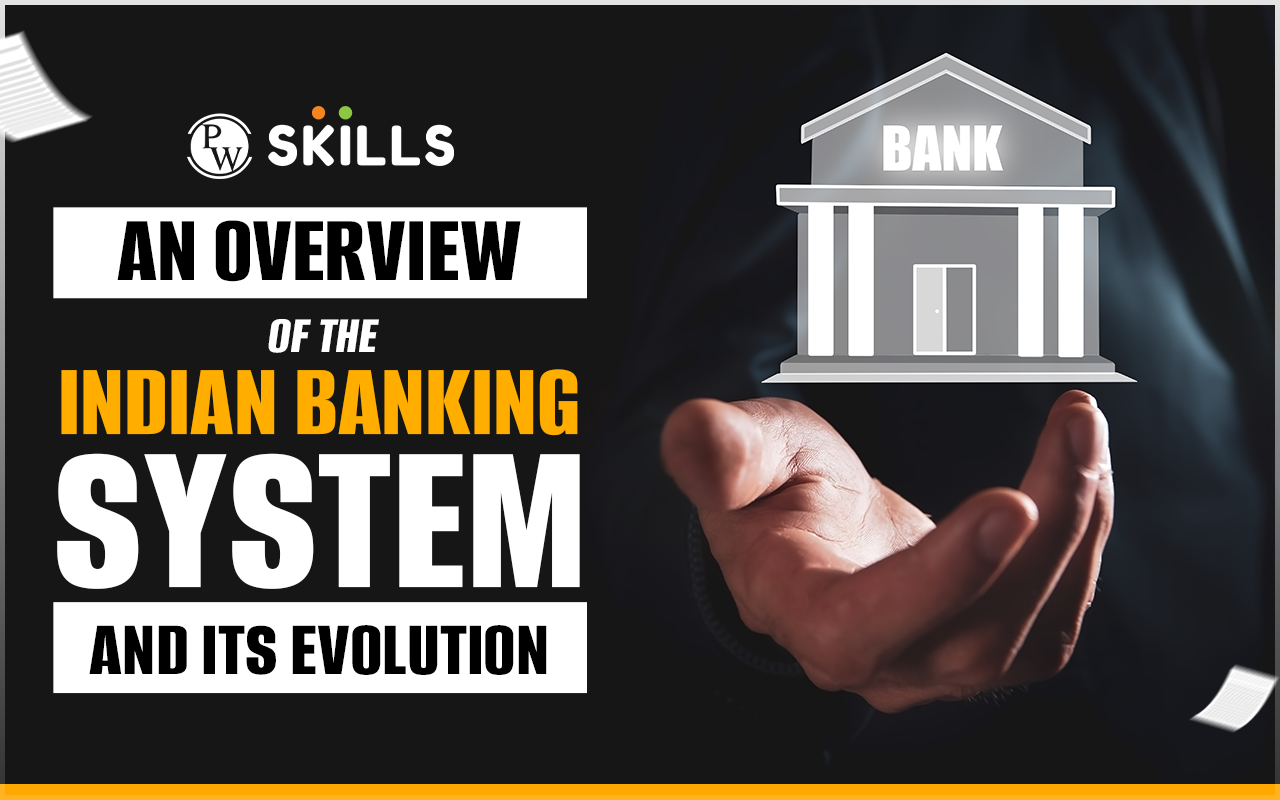Indian Banking Sector Overview
The banking sector plays a critical role in the economic development of the country economically. There are a lot of changes that have taken place over the past few years in the country technologically. Many financial services and products have come into the market. The Indian banking system has different types of banks such as commercial, small finance and cooperative banks. These banks are operated and abide by the guidelines that are set as per the Banking Regulation Act 1949.
Different Phases of the Indian Banking System
Phase 1 (1786 -1969)

This phase has lasted for over 200 years and this is before independence. In this period, there were around 600 banks and major developments have taken place during this era in the banking world. The first bank being started in India was the Bank of Hindustan. However, it was closed in 1932.
Presidency bank
Three presidency banks were started by the East India Company. The names of those banks include Bank of Madras, Bank of Calcutta and Bank of Bombay. All these banks were merged and renamed to Imperial Bank of India. However, soon the bank name was changed to State Bank of India. This all happened in 1955. After this period, more banks have come into the Indian banking world such as Punjab National Bank and Allahabad Bank. The banking sector saw a drop in its operation from 1913 to 1948. There were a lot of failures that the banking world has experienced. Not many people were confident about the banking sector of India resulting in slow mobilization of funds. There were a total of 1100 banks in this period.
Phase 2 (1969 – 1991)
After India gained independence, not many Indians were confident about the private banks. They will prefer to take money from the money lenders in their places if they need financial help. To overcome this issue, the Indian government has started over 14 commercial banks. These were nationalized in 1969. The key objective of the move is to not let the families in the country control power and wealth. Some of the reasons for nationalization include:
- Support agricultural sector
- Mobilize savings
- Expand the Indian banking network by increasing the number of bank branches
- Give a lot of scope for the private banks
A few of the banks that were nationalized in 1961 are:
- Central Bank of India
- Union Bank of India
- Bank of India
- Allahabad Bank
- United Bank
- Canara Bank
- Indian Overseas bank
Some of the banks that were nationalized in 1960 are:
- Corporation bank
- Vijaya bank
- Andhra bank
- Oriental bank of commerce
- New Bank of India
Financial Institutions
Some of the financial institutions that were established by the government with some objectives are:
- National Housing Board – It is to fund housing projects
- NABARD – To support agricultural-related activities
- SIDBI – To offer financial aid for people who want to start or expand their small-scale industries
- EXIM bank – It is to increase import and export
You can also refer to Indian banking sector overview 2024 growth of banking sector in India pdf to learn about the revolutions happening in the banking sector in India.
Benefits of Nationalisation
- Increase banking industry in India efficiency.
- Improve small-scale industries.
- Give a massive boost to agriculture.
- Increase the number of deposits made by the public.
- Give a better outreach.
- Increase employment opportunities.
Phase 3 (1991- Present)
The banking system has evolved. The Indian government is encouraged to receive foreign investments and accept private and foreign investors. During this period, online banking has become a revolution. There are a lot of online banking services offered to customers to allow them to bank in the comfort of their place. However, you can learn more about online banking in the BFSI course.
Many foreign banks operating in India include:
- Bank of America
- Citibank
- HSBC
- DBS Bank
- Royal Bank of Scotland
The nationalized banks were stabilized by forming the Narasimhan committee in 1999 to bring major changes in the banking sector. The government has also approved many private banks such as Axis Bank, ICICI Bank and IndusInd Bank.
Many reforms that happened in the banking sector:
- Small finance banks have got the approval to open many new branches across India.
- The government and RBI started to consider private and public banks almost the same.
- Banks are performing transactions and many other banking operations.
- Well-established payment banks have come into force.
Functions happening in the banking system:
- Will accept money deposits & withdraw the money any time you want.
- Offer loans of different types based on the requirements and interest rates.
- Offer debit and credit cards, fund remittance.
- Allow you to make bill payments & Internet banking.
Reasons For Nationalisation of Banks
The government has decided to nationalize banks due to the following reasons:
- Improve priority sectors – The banks were collapsing at a brisk pace. A total of 361 banks were closed between 1947 to 1955. Many customers have lost deposits and were not able to recover those deposits.
- Neglected the agricultural sector – Many banks have been showing interest towards large industries and businesses and have ignored the rural sector.
- Expand the number of branches of the bank – Due to nationalization, the banks can start new branches to expand the banking services to people in different nooks and crannies of the country.
- Mobilization of savings – When the banks are nationalised, people will get access to banks allowing them to save money in banks. This will inject additional revenue that can eventually increase the economy of the country.
Types Of Banks in India
The following are four different types of banks that exist in India right now:
Commercial banks
The banks need to abide by the regulations and rules set as per the Banking Regulations Act 1949. These banks will take deposits from banks and will start to give loans to the people who need them by taking less interest and earning profits through it. These types of banks are categorised into different types such as regional rural banks, public sector banks, and foreign banks.
Small finance banks
These banks will offer financial aid to people in different segments of the society. The customers to whom the financial assistance is offered are small business units, micro industries and so on. The banking sector introduction was started simple and soon has spread its wings digitally.
Cooperative banks
There will be a committee that will control the banking operations. These banks are not intended to make profits. In these types of banks, the customers will be owners. Banks that are categorised into cooperative banks are state cooperative banks and urban cooperative banks.
Payment banks
This type of bank will only accept some amount of deposit from customers. The banks will provide both the current and savings account services. The bank will also issue debit cards to its customers. However, based on the RBI norms, it won’t offer credit cards to its customers.
Digital Banking in India
Digital banking is a revolution meaning all the banking operations are digitized from its traditional approach. To open an account, FD account or to transfer money, customers do not have to visit the bank. In 2016, the Unified Payment interface system was introduced and BHIM was started by the National Payments Corporation of India (NPCI) to revolutionize the mobile banking system.
The banks have introduced Electronic funds transfer systems like NEFT and RTGS to send huge amounts of money to the recipient globally. An Aadhar biometric identification system has been started to open a bank account through a simple KYC procedure.
In 2021, Niti Aayog has proposed digital banks that will rely on the Internet to offer banking services without having to visit physical branches.
Conclusion
If you are preparing to build a career in the banking sector, it is necessary to have a good understanding of banking evolution to answer the questions in the exams. If you are looking for a credible banking course, then why not consider a BFSI course from PhysicsWallah that adds value to your bank exam preparation. Enroll for this course right today to avoid missing a great learning opportunity.
FAQs
What are the different phases of the banking revolution that happened in India?
There are three different phases in which the bank revolution has happened: Pre-nationalisation phase (1947 to 1969), Post-nationalisation phase (1969 to 1991) & Liberalization phase (1991 to till date).
What is the significance of banking in India?
The banking sector in the country manages the flow of money between different businesses and people.
What types of scheduled banks are available in India?
The types of scheduled banks available are private sector banks, foreign banks, public sector banks and regional banks.
What is a commercial bank that was started in India?
Oudh commercial bank is the first commercial banking that was started in India.
When was the first bank in India founded?
Bank of Hindustan was the first bank started in India and in the year 1770 Calcutta.








